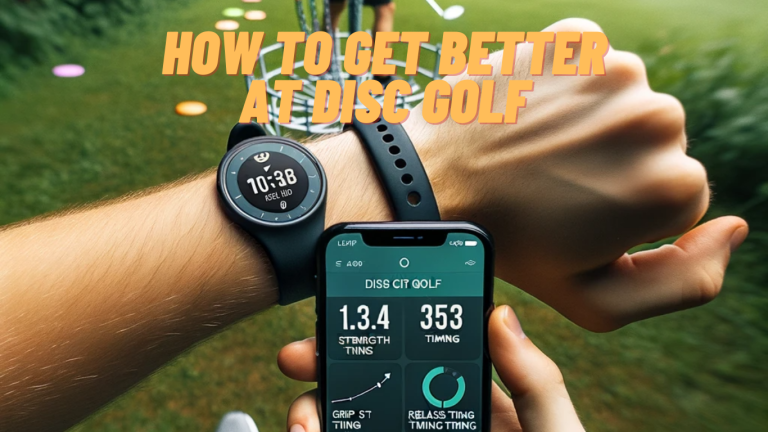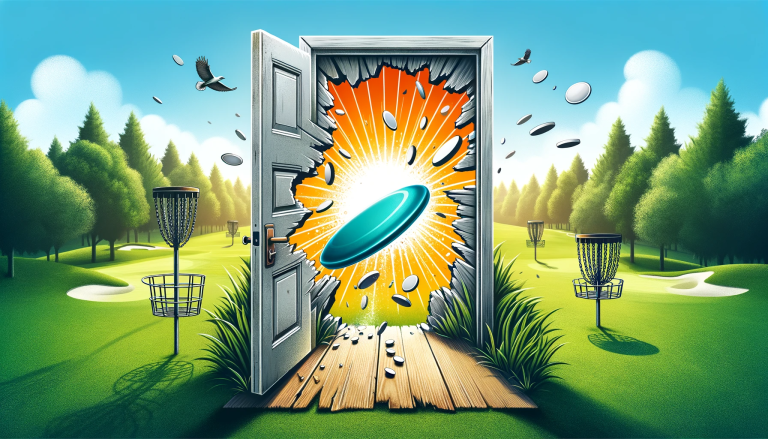How To Read Disc Golf Numbers? Essential Guide to Understanding Disc Golf Numbers
Reading disc golf numbers felt like deciphering a secret code when I first started playing. In this fascinating world of disc golf, understanding these numbers is crucial, akin to unlocking a hidden language that can dramatically improve your game. As a passionate disc golfer, I’ve spent countless hours on courses, slowly unraveling the meaning behind these mysterious digits.
Each number on a disc golf disc – whether it’s speed, glide, turn, or fade – tells a unique story about how that disc will fly. Think of it as a mini-biography of your disc’s potential in the air. From my experience, getting to grips with these numbers can transform a beginner into a savvy player, capable of making informed choices before each throw. So, let’s dive in and decode these numbers together, enhancing our understanding and love for this amazing sport.
How To Read Disc Golf Numbers?
When I embarked on my disc golf journey, the array of numbers on each disc baffled me. These numbers, I soon realized, are the Rosetta Stone of disc golf, offering insights into each disc’s flight characteristics. I’ve learned through practice and observation that understanding these numbers – speed, glide, turn, and fade – is fundamental to mastering the game. Each disc tells its own flight story through these figures, influencing how you strategize and play.
Imagine these numbers as a secret language, which, once understood, opens up a new realm of precision and skill in your game. Join me as we explore this numerical landscape, unraveling the mysteries of disc golf numbers to improve our play and deepen our enjoyment of this captivating sport.
Introduction to Disc Golf and Its Growing Popularity
Ever since I threw my first disc, I’ve been hooked on disc golf. It’s an exhilarating sport that combines the precision of golf with the casual fun of a Frisbee. Disc golf has been gaining tremendous popularity across the USA, and for good reason. It’s accessible to people of all ages, easy to start, and a fantastic way to enjoy the outdoors.
But what really adds depth to this sport is its technical side, particularly understanding how to read disc golf numbers. Whether you’re a newbie or a seasoned player, getting the hang of these numbers can be a game-changer. They’re not just arbitrary digits; they’re a critical part of your disc golf strategy, helping you select the right disc for every shot.
In this guide, I’m going to share everything I’ve learned about reading these numbers. From the basic principles to some insider tips, I’ll walk you through what each number means and how you can use this knowledge to improve your game. Trust me, once you get this down, you’ll see disc golf in a whole new light. Let’s dive in and discover the magic behind these numbers!
What are Disc Golf Numbers?
When I first laid eyes on a disc golf disc, those numbers felt like a puzzle. Disc golf numbers are essentially a rating system that describes how a disc is expected to fly. They’re not just random; they hold the key to understanding a disc’s behavior in the air.
The Birth of Disc Golf Numbers
The history of these numbers is pretty neat. They emerged as the sport grew, providing players a way to quickly gauge a disc’s potential. Before these numbers, it was mostly guesswork and word-of-mouth. Today, they’re a universal language in disc golf, giving players anywhere a common ground to discuss and choose their discs.
Decoding the Numbers
Now, let’s break these numbers down. There are four main ones: Speed, Glide, Turn, and Fade.
Speed: This tells you how fast a disc needs to be thrown. It’s not just about raw power; it’s about finding the sweet spot for each disc to perform its best.
Glide: Glide is all about how long a disc will stay in the air. The higher the number, the longer it will sail. It’s like the hang time of the disc.
Turn: This number shows how much a disc will turn to the right (for a right-handed backhand throw) during the initial part of its flight. A disc with a high turn can curve more, making it ideal for certain shots.
Fade: Finally, fade is about the disc’s tendency to hook left (again, for a right-handed backhand throw) as it slows down. It’s crucial for planning your disc’s landing spot.
You May Also Like: How To Throw Hyzer Flip?
Each of these numbers plays a crucial role in how a disc golfs. Knowing how to read disc golf numbers is like having a secret playbook, helping you make smarter choices for every shot. Stick with me, and we’ll delve even deeper into each of these numbers, unlocking their mysteries and enhancing your game!
Breaking Down the Numbers
Speed
When I first threw a disc in disc golf, the concept of speed was a bit elusive. In simple terms, speed indicates how fast a disc should be thrown to achieve optimal flight. But it’s not just throwing with all your might; it’s about controlled power.
Higher speed numbers mean the disc can handle more power and speed. These discs are great for long distances, but they require more skill and strength to throw effectively. Lower speed discs are more forgiving and better suited for beginners or for precise shots.
For instance, using a high-speed disc for a short distance often results in less control. As I progressed in disc golf, understanding the right speed for each shot significantly improved my game strategy and shot selection.
Glide
Glide is all about how long your disc stays in the air. Initially, I underestimated its importance. A disc with a high glide rating will stay airborne longer, which can add distance to your throws.
But more glide isn’t always better. On windy days, a high-glide disc can be unpredictable. On the flip side, in calm conditions, these discs can be incredibly useful for covering more ground.
Learning to balance glide with other factors like speed and wind conditions is a subtle art in disc golf. It’s fascinating how a disc with a higher glide can change the entire dynamic of a throw.
Shaping Your Shot
The turn of a disc is about its ability to curve right (for a right-handed backhand throw) during the initial part of its flight. This was a game-changer for me.
A disc with a negative turn rating is easier to throw for beginners because it naturally curves right, reducing the likelihood of it veering too far left. However, in the hands of an experienced player, a low or negative turn disc can be manipulated for creative and controlled curving shots.
Understanding turn helped me explore different flight paths and approach shots from new angles, enhancing the strategic aspect of my game.
Fade
Lastly, fade is about the disc’s tendency to hook left at the end of its flight (for right-handed backhand throws). This number became crucial in planning where my disc would land.
A higher fade rating means the disc will curve more sharply at the end of its flight. This is great for avoiding obstacles or making the disc stop quickly.
However, a disc with less fade is more predictable and can glide straighter for longer, which is excellent for open and long shots. Learning to use fade to my advantage allowed me to tackle different course layouts with more confidence.
Each of these numbers – speed, glide, turn, and fade – plays a vital role in how a disc behaves in flight. As I dove deeper into the world of disc golf, understanding these aspects not only made me a better player but also enriched my appreciation for the sport’s complexity and strategy.

How to Read and Interpret These Numbers
Deciphering the Disc Golf Code
The first time I picked up a disc golf disc, the numbers seemed like a secret code. It took some time, but learning how to interpret these numbers was like unlocking a hidden level of the game. Each number on a disc tells a part of its story: how it flies, how it turns, and where it’ll likely land.
Cracking the Code: Understanding Disc Flight Characteristics
Mastering the intricacies of speed, glide, turn, and fade numbers unveils the secret language of disc flight characteristics. For example, a disc with high speed, ample glide, minimal turn, and strong fade is tailored for launching long, straight shots with a pronounced leftward finish. Conversely, a disc boasting lower speed, moderate glide, substantial turn, and minimal fade prioritizes control and finesse, making it an ideal choice for beginners or for executing precise curved shots through tight spaces.
These numerical values aren’t arbitrary; they are meticulously calculated based on the disc’s design and intended application. My journey to decipher these combinations has proven invaluable, enabling me to make well-informed choices when selecting discs for specific situations. This understanding has been a game-changer, significantly enhancing my competitive edge on the disc golf course.

Practical Examples in Action
Let me give you a real-life example. One of my favorite discs is a ‘Speed 7, Glide 5, Turn -2, Fade 1’. This combination means it’s moderately fast, has good glide, and is ideal for straight shots with a slight right curve (for a right-handed backhand throw) and a gentle fade at the end. It’s my go-to for mid-range shots where accuracy is key.
Another disc I often use has the numbers ‘Speed 10, Glide 4, Turn 0, Fade 3’. This one’s faster, with less glide, no turn, and a stronger fade. It’s perfect for longer, straight shots where I need the disc to finish to the left.
Learning how to read and interpret these numbers transformed how I approach each course. It’s like having a strategic toolkit at my fingertips, tailor-made for every throw and every course.
Choosing the Right Disc Based on Numbers
Navigating the Numbers for Your Style
When I first delved into disc golf, selecting the right disc felt overwhelming. Now, after much trial and error, I’ve realized the power of understanding disc numbers for enhancing playing style. For beginners, a disc with lower speed and a neutral turn (like Speed 3, Glide 3, Turn 0, Fade 1) can be much more manageable, making the learning process smoother and more enjoyable.
Tailoring Disc Choices to Skill Level
As your skills advance, experimenting with discs that have varied numbers becomes key to mastering different throws. I noticed that experienced players often prefer discs with higher speed and fade for powerful, precise shots. They choose their discs based on the specific requirements of each shot, whether it’s a long, straight drive or a sharp curve around an obstacle.
Experimentation Leads to Perfection
The magic of disc golf lies in experimenting with different numbers to find what works best for your unique playing style. I encourage everyone to try a range of discs, from understable to overstable, to truly grasp the impact of each number. This exploration not only improves your game but also deepens your appreciation for the sport’s intricacies. Remember, the right disc can be a game changer, literally!

Dispelling Disc Golf Number Myths
In my journey through disc golf, I’ve encountered numerous myths surrounding disc numbers. One common misconception is that a higher speed disc will automatically travel farther. This isn’t necessarily true, especially for beginners. Speed potential is fully realized only with the right power and technique, which takes practice to develop.
Interpreting Numbers Correctly
Another area where players often trip up is misunderstanding the glide number. It’s not just about how far the disc will fly, but also how it will behave in the air. For instance, a disc with a high glide is great for distance but can be tricky to control in windy conditions. Learning the nuances of these numbers can significantly improve your game.
Avoiding Common Pitfalls
The biggest mistake I see players make is choosing discs based solely on professional player preferences. What works for a pro may not suit a beginner or intermediate player. It’s essential to choose discs that complement your skill level and playing style. Remember, understanding and choosing discs based on their numbers isn’t just about technicalities, it’s about enhancing the fun and effectiveness of your game!
Reflecting on Disc Golf Numbers
As we wrap up, let’s revisit the essentials we’ve covered about how to read disc golf numbers. We’ve broken down the meanings of speed, glide, turn, and fade, and how they shape the behavior of a disc in flight. I’ve shared personal insights on interpreting these numbers, alongside the common mistakes to avoid, and how to choose the right disc for your game.
You May Also Like: How To Play Disc Golf For Beginners?
Embrace Experimentation
One key takeaway is the value of experimentation. Each player’s style and skill level is unique, and finding the right disc is a personal journey. Don’t shy away from trying different combinations of speed, glide, turn, and fade to discover what works best for you.
The Joy of Mastery
Finally, remember, mastering disc golf numbers adds a rich layer to the game, enhancing not just performance but also the joy of playing. Whether you’re a seasoned player or just starting out, understanding these numbers can transform your experience on the course. Here’s to many more games of joyful discovery and improvement!
FAQs
Q1:What does each number in disc golf signify?
Answer:
The numbers represent speed, glide, turn, and fade, each influencing how the disc flies and lands.
Q2:How important is it to understand disc golf numbers for beginners?
Answer:
Understanding these numbers is crucial for beginners to choose the right disc and improve their game.
Q3:Can disc golf numbers predict the exact flight path of a disc?
Answer:
While they offer a guide, many factors like wind, technique, and disc wear also affect the disc’s flight.







